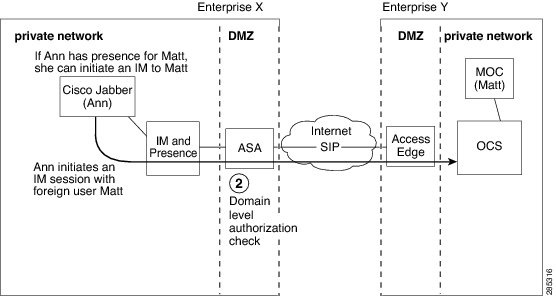Basic Federated Network
This integration enables the IM and Presence Service users from within any domain that IM and Presence Service manages to exchange availability information and Instant Messaging (IM) with users in external domains. The IM and Presence Service uses different protocols to federate with different external domains.
The IM and Presence Service uses the standard Session Initiation Protocol (SIP RFC 3261) to federate with:
-
Microsoft Office 365 (business to business)
-
Microsoft Skype for Business 2015, Standard Edition and Enterprise Edition (business to business)
-
Microsoft Lync 2010 and 2013, Standard Edition and Enterprise Edition 
Note
IM and Presence Service supports interdomain federation with Microsoft Lync. For IM and Presence Service , any reference to interdomain federation with Microsoft S4B/Lync also includes Microsoft Office 365, unless explicitly stated otherwise.
IM and Presence Service uses the Extensible Messaging and Presence Protocol (XMPP) to federate with:
-
IBM Sametime Server 8.2 and 8.5
-
Cisco WebEx Messenger
-
IM and Presence Service 9.x and up
-
Any other server that is XMPP Standards compliant
 Note |
If you wish to enable XMPP federation with an external domain, ensure that the external domain was not previously configured as a SIP federated domain on the IM and Presence Service. Example: An IM and Presence deployment with example.com was historically configured as a SIP based federation. But example.com has now added XMPP support, so the local administrator instead wishes to enable an XMPP based federation. To allow this, the local administrator must first delete example.com as a SIP federated domain on the IM and Presence Service. |
The following figure provides an example of a SIP federated network between IM and Presence Service enterprise deployment and Microsoft S4B/Lync enterprise deployment.

This example shows the messaging flows for a multi-cluster IM and Presence Service deployment where SIP Federation is enabled in one cluster only. A single routing node receives all incoming IMs from the Expressway-C and reroutes the IM to the correct node in either cluster. Outgoing IMs can be sent to the Expressway-C from any node in either cluster.
In the figure, each internal enterprise domain interconnects over the public internet using its DMZ edge server using a secure TLS connection. Within the internal IM and Presence Service enterprise deployment, the Cisco Adaptive Security Appliance provides firewall, Port Address Translation (PAT), and TLS proxy functionality. The Cisco Expressway-C routes all incoming traffic initiated from the external domain to a designated IM and Presence Service node.
The following figure provides an example of a multi-cluster XMPP federated network between IM and Presence Service enterprise deployment and an IBM Sametime enterprise deployment. TLS is optional for XMPP federation. Cisco Adaptive Security Appliance acts only as a firewall for XMPP federation; it does not provide TLS proxy functionality or PAT for XMPP federation. IMs can be sent and received from any node that has Federation enabled. However, Federation must be configured in parallel in both clusters.

There are two DNS servers within the internal IM and Presence Service enterprise deployment. One DNS server hosts the IM and Presence Service private address. The other DNS server hosts the IM and Presence Service public address and DNS SRV records for SIP federation (_sipfederationtls), and XMPP federation (_xmpp-server) with the IM and Presence Service. The DNS server that hosts the IM and Presence Service public address is located in the local DMZ.









 Feedback
Feedback